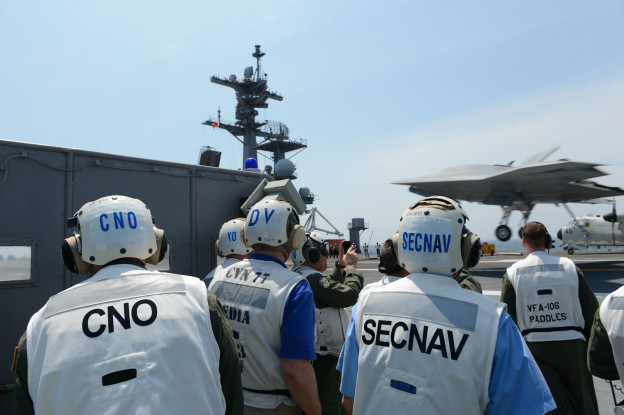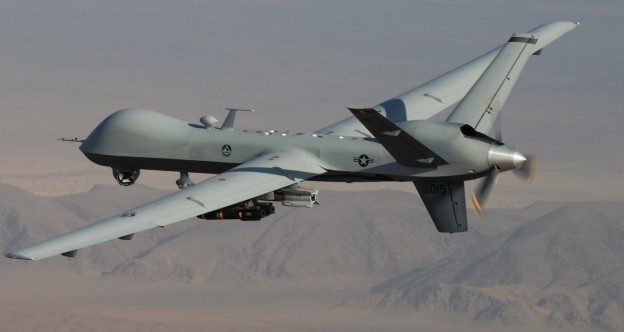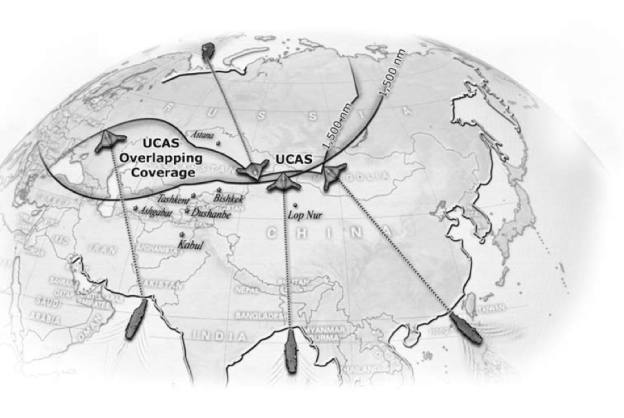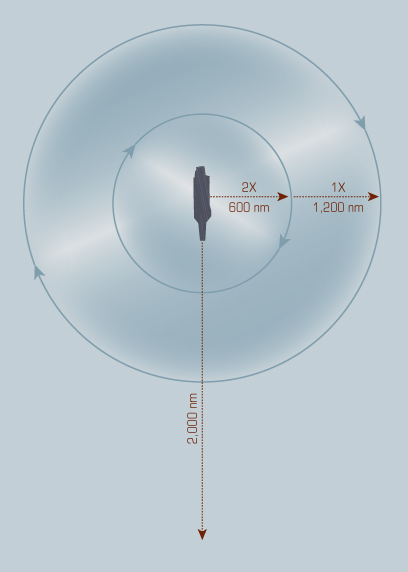
Pentagon leaders altered the Navy’s vision of creating an unmanned aerial vehicle (UAV) capable of striking defended targets thousands of miles away from the sea into a less-capable platform more suited for hunting terrorists, USNI News has learned.
Several sources told USNI News the change in focus of the Unmanned Carrier-Launched Surveillance and Strike (UCLASS)—overseen by the Pentagon’s Joint Requirements Oversight Council (JROC)—was based on keeping costs down and a desire to keep unmanned counterterrorism missions as an U.S. military option without the need for foreign basing.
UCLASS was originally conceived to integrate with a carrier air wing and act in concert with manned-strike fighters to hit targets in heavily defended air spaces from thousands of miles away with a weapons payload equivalent to the planned carrier-based F-35C Lighting II Joint Strike Fighter (JSF). A stealthy UCLASS would also provide long-distance information, reconnaissance and surveillance (ISR) capabilities for the carrier strike group (CSG) and refuel by air.
Instead—according to draft requirements obtained by USNI News in June—a new UCLASS outline developed within the last year calls for an aircraft with a payload that can carry a fraction of the weapons originally planned, not as stealthy and can’t operate in a heavily contested airspace.
From J-UCAS to UCLASS
UCLASS was born from the cancellation of the Joint Unmanned Combat Air System (J-UCAS) program developed for the Air Force and the Navy as outlined in the 2006 Quadrennial Defense Review (QDR)—the Pentagon’s four-year planning document.

The new concept would have the Navy develop a carrier-based UAV that could bring an added degree of relevance to carriers, which more and more are threatened by long-range guided weapons, while the Air Force would continue to develop a long-range bomber.
“UCAS was going to have ISR and a weapons-delivery capability but was also an airplane that could stay up for long periods of time that could do penetrating ISR, that could do strike,” former Chief of Naval Operations and current member of Northrop Grumman’s board of directors, Adm. Gary Roughead told USNI News on Wednesday.
The tailless and stealthy airframe—Northrop Grumman’s X-47B—was designed to meet the concept from the 2006 QDR and test the fundamentals of the platform.
“It was supposed to prove that you could land a tailless aircraft safely on the carrier,” Bob Work, former under secretary of the Navy and current CEO of the Center for a New American Security, told USNI News on Thursday.
Northrop Grumman rolled out the first test aircraft in 2008 and flew it for the first time in 2011. In July, the X-47B proved an autonomous UAV could successfully land on a carrier in a test aboard the USS George H.W. Bush (CVN-77).
Change in Vision
The same year UCAS-D had its first flight, the concept of UCLASS began to change inside the Pentagon.
In 2011 the Office of the Secretary of Defense (OSD) and the JROC—chaired by then-new Vice Chairman of the Joint Chiefs of Staff Adm. James “Sandy” Winnefeld—began to take more control of UCLASS development.
“The money provided for the UCLASS program was inserted by OSD into the Navy’s budget,” Work said. “OSD then became the primary of what the requirements would be because it was their money.”
A camp in OSD began to develop a concept that would gear UCLASS toward a cheaper version focused on counterterrorism missions that wouldn’t operate in a heavily contested airspace.
Those missions—currently flown by Air Force MQ-1 Predator and MQ-9 Reaper unmanned aerial vehicles (UAVs)—focus on tracking and eliminating so-called “high value” terrorism targets as part of the United States’ ongoing antiterrorism campaign, responsible for the deaths of several senior terrorist leaders.

But the ability for the United States to fly those missions is contingent on permission from foreign governments.
“Operating from a host country gives them the ability to put whatever restrictions they want on your operations. I’m talking about policy restrictions that they want you to follow,” retired Air Force Maj. Gen. Charles Dunlap, told USNI News. “In terms of policy there are a lot fewer restrictions from a seabase.”
Several sources told USNI News the White House was keen on continuing to fly counterterrorism missions without the need for foreign basing—including using carriers.
Winnefeld spokeswoman Air Force Lt. Col. Catie Hauge told USNI News the White House had no input into the UCLASS requirement and White House national security staff spokeswoman Caitlin Hayden declined to comment.
Work said what followed the 2011 OSD maneuver was “a pretty healthy debate,” over the UCLASS requirements. “One school said, ‘We have already more than 800 aircraft, like Reapers and Predators, that can operate in non-contested airspace,’” he said.
“What you don’t have is a lot of capability in stealthy type penetrators.”
The second position said counterterrorism and irregular warfare missions were going to be around for some time—and you can’t always count on land bases.
“The debate was still going on when I left the department,” said Work, who left in May. “I think that the Joint Staff was focused on the lower-end type of system and they were pushing that really hard. The Navy was negotiating, saying, ‘at least we need to have some growth capability in there.’”
Both the Navy and OSD requirement offices said that counterterrorism missions would be part of the UCLASS mission set in statements provided to USNI News.
Work said he disagrees with the focus on counterterrorism. “The carrier is a $10 billion asset with a $6 billion air wing,” he said. “I don’t see you plopping that off the coast of Africa reaching out and trying to find a high value [terrorist] target.”
Capability vs. Cost vs. Orbits
In 2011 President Obama signed the Budget Control Act that introduced the looming 10 percent across-the-board spending cuts for the Department of Defense (DOD) that went into effect in early 2013.
Those decisions from the administration and Congress have led to examinations of existing programs and overwhelming focus on the cost of programs.
Earlier this month, Dyke Weatherington, the Pentagon’s director of unmanned warfare and ISR, said fiscal pressures were to blame on the change in UCLASS.
The DOD, “can’t afford to start programs that we can’t finish. We can’t afford to start programs that we get two or three into and we have to cancel and we have nothing to show for it,” he said.
But the possibility of small numbers of UCLASS was a part of the original plan for the $2.3 billion program.

“The initial intent was to get an operational detachment for a carrier, as many of those as you can get,” Work said. “If you could get one or two, you would rotate those through the deployable carriers, those going to the Western Pacific or those going to CENTCOM depending on what you needed. You would try and go from there.”
Winnefeld instead advocated for a maximum number of available aircraft to create more carrier orbits, changing the initial UCLASS cost calculus in a Dec. 19 memo.
“The numbers of available orbits provided as a fielded capability within total program budget is the Number One priority for UCLASS,” Winnefeld wrote according to a March Inside the Pentagon report.
“In light of the modified guidance, the JROC recommended the office of cost analysis and program evaluation — in the Office of the Secretary of Defense — ‘complete an update of the analysis of alternatives’ by March 31 that reflects changes the panel directed to the UCLASS requirement,” reported the news service.
As part of the new key performance parameters (KPPs), the unit cost for the aircrafts, less research and development and operations and maintenance cost (known as recurring flyaway cost), “required to conduct a 600 nautical mile persistent orbit shall not exceed $150 million.”

Though the orbits would be the primary mission, the KPPs included a requirement for UCLASS to have a direct strike radius of 2,000 nautical miles.
The Navy anticipates the maximum $150 million cost of the orbit will buy at least two airframes.
The change in direction also muted the initial goal to have UCLASS integrated into the air wing as an equal combatant.
The current plan for UCLASS is to have the aircraft fly from the carrier during the hours the manned air wing isn’t flying, according to an USNI News interview with Navy requirement officials in June.
“You can launch UCLASS at the end of your fly day and it can span that gap while your flight deck is shut down,” said Capt. Chris Corgnati, branch head for the unmanned aerial systems requirements and resources in the Office of the Chief of Naval Operations.
Work chalks the new position up to a “reticence” in the carrier aviation community to fully integrate manned aircraft with unmanned. In a manned and then unmanned operation, “you completely decouple truly integrated operations. In my view, it’s entirely the wrong way to look at this,” he said.
The Future for UCLASS
How much the Navy will be able to grow the UCLASS into the original UCAS vision will depend on how the Pentagon structures the series of requests for proposal (RFP) the Navy plans to issue starting in September.
“The RFP was going to help define this. I haven’t seen the RFP since I left, I don’t know what it is looking like, and it’s going to have change because of sequestration,” Work said.
Now the four companies that have expressed interest in building UCLASS and plan to compete for the contest—Lockheed Martin, Boeing, General Atomics and Northrop Grumman—will have to navigate the new vision for the program.
“The RFP in my view has to at least be able to grow the capability. If all this is going to be is about cost. You will inevitably going to be driven toward a lower end system—which I don’t think the joint force needs,” Work said.
The Navy plans to field UCLASS by 2020.





